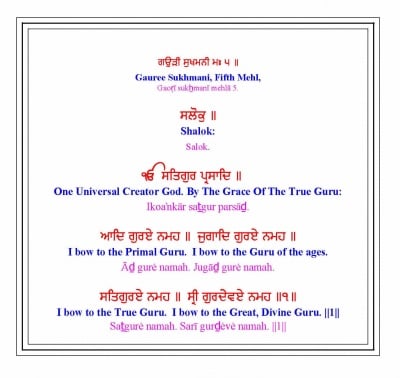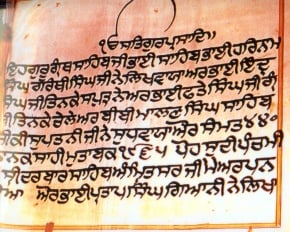Sukhmani

Sukhmani or Sukhmani Sahib is the title given to the Gurbani in raga Gauri Sukhmani[1] in the Guru Granth Sahib which in turn appears in the major musical measure Raga Gauri. It is a lengthy composition, written by Guru Arjan Dev, the fifth Sikh Guru. The sacred prayer is 35 pages long from page 262 to page 296 of the Guru Granth Sahib. Surprisingly, many ardent Sikhs include the recitation of this Bani in their daily regimen of Nitnem. The physical site, where the Guru, around AD 1602-03, composed this composition was once enclosed by a dense wood. The location is still marked on the bank of the Ramsar pool in the city of Amritsar, near the famous Golden Temple, the Harimandir Sahib.
It is said that Baba Sri Chand, elder son of Guru Nanak and founder of the Udasi order, came to Amritsar to meet Guru Arjan, then engaged in composing this Bani. The Guru who had by that time completed sixteen astpadis, or cantos, requested that he continue the composition. Baba Sri Chand, out of humility, only recited the salok of Guru Nanak following the Mool Mantra in the Japji — “aaad sach, jugad sach; hai bhi sach, Nanak hosee bhi sach” — "True in the beginning, True through the ages; True even now; Nanak say, Shall remain ever True" (SGGS p285). This salok was thereupon repeated by Guru Arjan at the head of the seventeenth astpadi.
The word Sukhmani is rendered into English as “consoler of the mind.” The entire poem has been translated into English more than once under some commonly preferred titles, "Jewel of peace", “Psalm of peace” or “Song of peace”, signifying the soothing effect it has on the mind of the reader. Sukh literally means peace or comfort and mani means mind or heart. ( ਮਣੀ Sukh in Gurmukhi can also mean jewel, gem, precious stone. [2]).
The couplet, "Sukẖmanī sukẖ amriṯ parabẖ nĝm. Bẖagaṯ janĝ kai man bisrĝm. Rahĝo" translates to, "Sukhmani: Peace & pure ambrosial Nectar are in God's Name. The devotees' mind abide in bliss and calm peace. ||Pause||" constituting rahau, the only one in the composition, which means pause or rest and which is an equivalent of the Hebrew word selah occurring in the Psalms, sums up the most characteristic feature of this bani. According to this couplet, Sukhmani is the bringer of the bliss of the Lord’s name; it dwells in the hearts of those who love Him.
The Sukhmani Sahib has structural unity. The composition consists of 24 Astpadis each of which begins with a Salok and is followed by 8 Pauris or stanzas. Each stanza has ten lines, which consist of five couplets. There is also the unity of theme: the perfection of man mentally. morally and spiritually. The Salok at the beginning of each Astpadi (canto) gives the gist of the 8 Pauris (stanzas) that follow this salok.
One of the fundamental texts of the Sikh faith, the Sukhmani presents a complete scheme of the teachings of the Sikh faith. While each astpadi has a fresh vision to impart, a particular aspect of Truth to unfold, the whole text may be regarded as the reiteration of basic themes such as Divine immanence, Divine compassion, abundance of grace, God’s succouring hand, the merit of devotion, of holy company and humility. With such reiteration, the composition as a whole has a remarkable gripping quality reinforced by the striking imagery which in stanza after stanza brings home to the seeker the truths he must own.
Analysis

Sukhmani is a theological statement of the major tenets of Sikhism expressed in a devotional poetic form. Recited by the Sikhs as a part of their morning prayer, it is one of the easier texts to learn, in the Guru Granth Sahib. It is similar in syntax and structure, though its essential meaning will elude one not attuned to the spiritual experience and the idiom and phraseology of gurbani. The language character is close to Khari Boli, the Hindi that had evolved in the areas lying northwest of Delhi, with a distinct inclination towards Punjabi. The expression here, however, is poetic in its overtones and shares a common character with the variety of Hindi or Bhakha that was used by religious teachers all over northern India. While this language has evolved out of Braj, it is closer to Punjabi in its grammatical form. This will be substantiated by comparing it with the language of a poet writing in pure Braj, such as Surdas, who flourished around the same period as Guru Arjan. To indicate the differences of the language of Sukhmani from Braj even Bhakha, a few examples may be given:
Thivai (3.2) is Punjabi, so is ditha (7.7). Khate (12.5) is pure Punjabi. In niki kiri (17.5), niki (small) is Punjabi. Ohi (23.4)) is Punjabi, of which the Braj equivalent would be vehi, Hoi (past verbal form) is Punjabi. Bhau (18.7) for bhaya (fear) is an especial form given in gurbani and occurring frequently. The Punjabi character of language is especially decipherable in the forms of verb ending in the past tense. Kathia (8.7), pachhata (17.8), jata (19.8), in the sense of jania, japia (20.2), rahia (20.3), aradhia (salok 24) are some of the examples. Other verb forms to illustrate this point are utarasi (19.7) which, however, is also Rajasthani; bahai (15.2); lae (13.5) and laini (15.5). Here and there pure Hindi forms may be seen: hovat (21.1), tumari (20.7) and biapat (21.1). Japat rhyming with it in the same stanza is Punjabi with a Hindi ending.
The language of the Sukhmani can be best described as a synthesis of the Bhakha and Punjabi. In the more philosophical and meditative of their compositions, the holy Gurus are inclined to use a variety of Hindi with Punjabi overtones, while in the more deeply intimate pieces such as the chhants and pauris of Vars, [[]]Punjabi, in its dialectical variations, has been employed. This principle, by no means absolute, is only broadly applicable.
Structure of Sukhmani
- Main article: Structure of sukhmani
The Sukhmani comprises twenty-four astpadis or cantos, each comprising of eight Pauris or stanzas. They are composed in the metre chaupai. A salok or couplet precedes each astpadi. Also each Pauri consists of 5 couplets consisting of 10 Tuks or lines. The first seven stanzas of the astpadi explore the theme stated in the preceding saloks and the eighth sometimes sums up the astpadi but, more often, becomes a paean of praise placing the theme in the context of an overall vision of Eternal Reality. This structure is maintained throughout the composition, from Astpadi to Astpadi. The theme of the Astpadi may give the impression that no traceable progression of thought is taking place as in a philosophical work, but there is a continuing unity of spiritual and ethical tone througout the text.
Summary of the message
- Main article: Message of sukhmani
Below is a table summarising the message of the 24 Astpadis in the Sukhmani Sahib. The table is broken down Astpadi by Astpadi:
| Astpadi | Message of the Bani in this Astpadi |
|---|---|
| 1 | sums up the benefits of contemplation and meditation. |
| 2 |
tells us that "practising holiness" reduces man's propensity to sin. |
| 3 |
the Guru states that any study of holy texts, the performance of austerities. etc cannot compare with reading or listening to the Sacred Word. |
| 4 |
stresses the need for good behaviour. |
| 5 |
we learn to thank God for all his various gifts and treasures which He gives us. |
| 6 |
examples God's gifts to man: a healthy body, delicacies to eat, silks and jewels to wear and pleasant music to hear. |
| 7 |
dwells on the attributes of the saints: |
| 8 |
Similarly to 7, an appreciation of the God-oriented man- the Brahm-giani -is found here. |
| 9 |
Guru Arjan defines the various types of holy persons like the Pandit, Vaishnav, Bhagwati, etc |
| 10 |
This deals with the various types of people and substances, both good and bad. |
| 11 |
The Guru tells us that the meek and the humble win God's love, while the haughty and the vain find no peace or joy. |
| 12 |
dwells on the lot of the boastful and the arrogant. |
| 13 |
tells us of the need to associate with saintly people and of avoiding their slander. |
| 14 |
points out that mortals, by their very nature, are fickle and way-ward; so no reliance can be placed on them. |
| 15 |
just as darkness is dispelled by light, and wilderness is illuminated by lightning, the Guru's instruction opens up the mind. |
| 16 |
the Guru refers to God as the Director, Playwright and Actor in His own plays. |
| 17 |
the Guru emphasizes the qualities of a true servant of God, namely obedience and humility. |
| 18 |
stresses the characteristics of a Seeker of Truth. |
| 19 |
Guru Arjan warns of the distractions of life. Why waste one's life amassing wealth? |
| 20 |
deals with the need of efforts for spiritual progress. |
| 21 |
the Guru tells of the pre-creation state. Before creation, there was a great void. |
| 22 |
there is a short list of God's attributes. He is the fountain of generosity and goodness. |
| 23 |
tells us of the omnipotence of God. He created the fabric of the universe; He controls the stellar bodies. |
| 24 |
the benefits of the Sukhmani are expounded. The true devotee will be rewarded with health, culture, wisdom, peace, etc. |
Significance, Contents and Theme
- Main article: Importance of sukhmani
There is a great significance of Sukhmani in the Sikh way of life and also enjoys reverence among the devotees of the Sikh faith. They used to recite it in the early hours of morning. Generally it takes more than half an hour to recite it. Any one who reads it with love, faith and devotion opens the doors of the treasure of eternal bliss and the very spring of peace, the reason being that the author (Sri Guru Arjan Dev ji) has poured into this composition his very spirit which was peace itself. This peace he had got from his constant communication with God. It is a treasure of all kind of happiness and pleasure.
See also
- Learn Sukhmani sahib
- Structure of sukhmani
- Message of sukhmani
- Importance of sukhmani
- Guru Arjan
- Amritsar
- Bani
- Bhai Vir Singh
- Brahm Giani
- Nitnem
- Learn Gurbani
- Gurbani
External Links
- Concepts In Sikhism - Edited by Dr. Surinder Singh Sodhi
- Pak minister transliterates Sukhmani Sahib into Persian & Shahmukhi
Text
- scribd.com Sukhmani Sahib in Gurmukhi, Hindi and English
- scribd.com Sukhmani Sahib in Gurmukhi
- sikhnet.com download doc file
- gurbanifiles.net Download pdf file - Gurmukhi, Hindi and English
Video
Audio
- Guriqbal Singh (Gurdwara Mata Kaulan Amritsar Wale) - Sri Sukhmani Sahib Ji Diyan Visheshtaian
- Giani Thakur Singh (Patiala Wale Damdami Taksal) - Katha Sukhmani Sahib
- Dya Singh (Australia) - Sukhmani Simren
- Gurdial Singh Paras - Sukhmani Sahib
- Harbans Singh (Jagadhari Wale) - Sukhmani Keertan
- Jarnail Singh (Damdami Taksal Wale) - Sri Sukhmani Sahib
References
Bibliography
- 1. Sabadarth Sri Guru Granth Sahib. Amritsar, 1975
- 2. Sahib Singh, Sukhmani Sahib Satik. Amritsar, 1939
- 3. Narain Singh, Giani, Sukhmani Sahib. Amritsar, n. d.
- 4. Sodhi, Teja Singh, Katha Dip Sagar (Sukhmani Sahib) Satik. Amritsar, 1959
- 5. Arshi, Sahib Singh, Sukhmani da Alochanatmak Adhyan. Jind, 1973
- 6. Macauliffe, Max Arthur, The Sikh Religion: Its Gurus, Sacred Writings and Authors.
Oxford, 1909
*7. The Perfect Man and Peace-Eternal by Bhai Sher Singh (MSc) Kashmir
- 8. Teja Singh, The Psalm of Peace.

